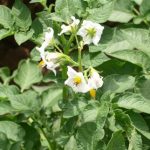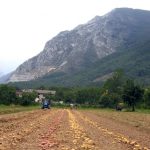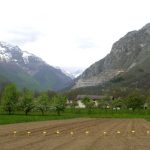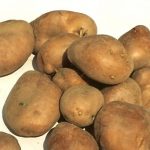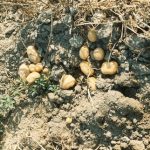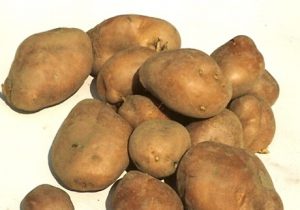
Name
Entraque Potato
Seal of quality

Seal of private and/or trades nature
Description
Potato planting, although widespread in any environment, finds its ideal habitat in mountainous areas. In fact, here the loose soils and cool climate on average rainier, favour this plant’s requirements and make it possible to have regular cycles of cultivation and tuber growth. Furthermore, mountain cultivations are usually of a less intensive nature, frequently utilising manure instead of chemical fertilisers, and weed killing is often mechanical or manual but not chemical. At certain altitudes, there are also fewer parasitic diseases and adversities and/or less virulent, for which it is possible to reduce or annul treatment altogether. On the other hand, the minor intensity of the cultivation carried out on soils on average less fertile than those on tablelands, if a lower yield is involved, enhances the organolpetic characteristics of mountain potatoes, resulting, moreover, in better storing capacities. Therefore, we can understand why these potatoes are-sought after by producers and why this cultivation has been maintained, even if with lower yields. Potato growing has been particularly maintained in certain medium and low mountain areas where this crop has found its perfect environment.
This is the case at the foot of the Bisalta, where the farmers have organised a Consortium to protect and develop the product grown here. Only potatoes grown on farms situated in the said areas can bear the seal of quality issued by the Consortium.
This is the case for the Comune di Entraque region, where the “Gruppo Produttori Patata Entracque” has been founded for the promotion and protection of the product here produced.
Today, modern varieties from different origins are grown, although they are trying to bring back old selections cultivated in the past on our mountains such as the Piatlìna, thus named for the flattened shape of the tuber.
Tubers are different according to the variety and differ in shape, size, colour of the peel and the pulp. Moreover, depending on the variety, potatoes differ according to their cooking suitability (fried, boiled, for gnocchi and mashed). In this sense, consumers buying potatoes should ask for information on the aptitudes of the varieties, according to what they will be used for, in order to obtain the best possible quality characteristics of each variety.
Nutritional characteristics
Follows the nutritional characteristics of Patata.
| FOOD | Patate crude | Patate, cotte senza buccia | |
|---|---|---|---|
| Edible part | % | 83 | 100 |
| Water | g | 78,5 | 80,1 |
| Protein | g | 2,1 | 1,8 |
| Fat | g | 1 | 0,1 |
| Carbohydrates | g | 17,9 | 16,9 |
| Starch | g | 15,9 | 15 |
| Soluble sugar | g | 0,4 | 0,4 |
| Total fibre | g | 1,6 | 1,3 |
| Energy | kcal | 85 | 71 |
| Kilojoules | kJ | 354 | 299 |
| Sodium | mg | 7 | 7 |
| Potassium | mg | 570 | 280 |
| Iron | mg | 0,6 | 0,4 |
| Calcium | mg | 10 | 5 |
| Phosphor | mg | 54 | 31 |
| Thiamine | mg | 0,1 | 0,08 |
| Riboflavin | mg | 0,04 | 0,01 |
| Niacin | mg | 2,5 | 0,5 |
| Vit A ret. eq. | mcg | 3 | tr |
| Vit C | mg | 15 | 6 |
| Vit E | mg |
Area of production
The production area concerns the commune of Entraque.
History
The potato, the botanic name of which is Solanum tuberosum, belongs to the Solanacee family, like tomatoes, peppers and aubergines, that arrived in Europe with the discovery of the Americas , but, at least in Italy and in Piedmont in particular, its cultivation began to be developed only in the 19 th century. It spread rapidly, mainly to satisfy the food requirements of most of the population in that period: speaking about cultivated land, the potato was the crop that guaranteed the highest yield and, therefore, was a frequent part of the traditional diet instead of cereals.
Potato growing spread particularly in mountain areas where the potato, called “bodi” in the Occitan dialect, or in some areas also “trifola”, “tartifla” or “tartifola” because of its similarity to the rare truffle, started being used daily, almost more than chestnuts and polenta. As far as variety is concerned, new ones are currently being planted, although in some cases there is an attempt to bring back old selections.
